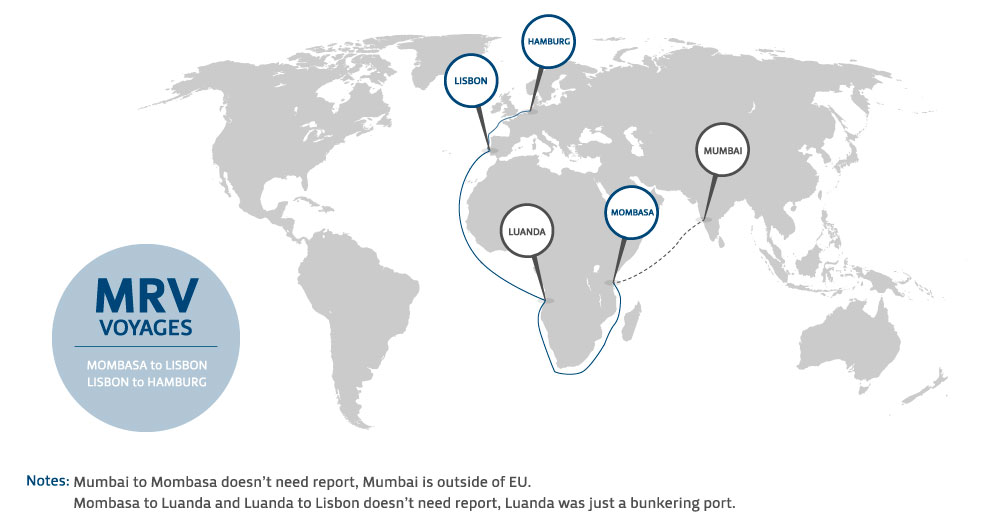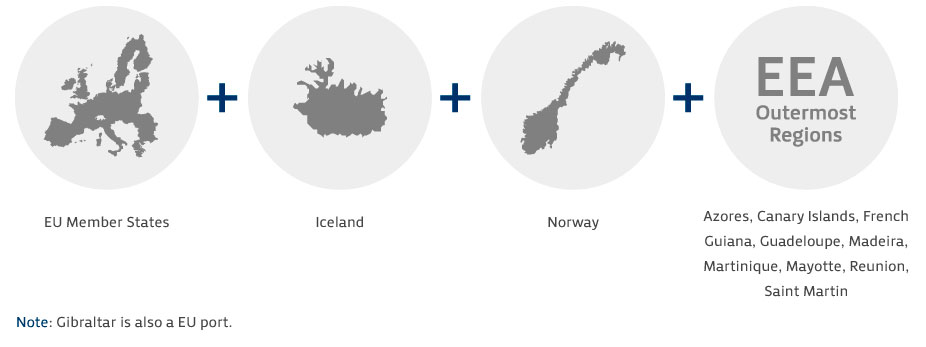It was prepared by Tecnoveritas and does not commit the European Commission. Only the Court of Justice of the European Union is competent to authoritatively interpret the Union law.
Due to this fact it was urgent to take measures and, therefore, the best possible option was to set up a system for monitoring, reporting and verification (MRV system) of CO2 emissions based on the fuel consumption of ships as a first step of a staged approach.
The penalties are defined by each Member State. It is appropriate to provide the possibility of expulsion for ships that failed to comply for two or more consecutive reporting periods with monitoring and reporting requirements.
Nevertheless, there are ships exempted from MRV:
- Warships;
- Naval auxiliaries;
- Fish-catching or fish-processing ships;
- Wooden ships of a primitive build;
- Ships not propelled by mechanical means;
- Government ships used for a non-commercial purpose;
- Dredging;
- Ice-breaking;
- Pipe laying;
- Offshore installation activities.
- Activities starting or ending in a port of call serving the purpose of transporting passengers and cargo for commercial purposes (voyages);
- Ballast voyages (where ships load or discharge cargo and/or passengers for commercial purposes between ports of call).
Any other ship activities that do not serve the purpose of transporting cargo or passengers for commercial purposes are not subject to the monitoring, reporting and verification requirements (ex: ice-breaking, prospection, and extraction of material, support to offshore installations).
In MRV context a voyage is considered a journey between two consecutive ports of call and an “EU MRV voyage” is considered when at least one of the ports of call is in the EU. The kind of voyages involved are:
- Voyages from ships that come from the last port of call outside of the EU to the first EU port of call;
- Voyages within EU ports of call;
- Voyages from EU ports of call to the first port of call outside the EU.
Besides the mentions voyages, it should also be considered the laden voyages. See the following example:


- CO2 emissions (based on emissions factors for each type of fuel);
- Fuel consumption at sea and at berth for each emission source;
- Voyage data (time at sea, distance traveled, cargo carried, transport work);
- Energy efficiency parameters (total fuel consumption per distance, total fuel consumption per transport work, total CO2 emissions per distance, and total CO2 emissions per transport work);
- Emissions sources (main engines, auxiliary engines, boilers, gas turbines, inert gas generators).
| Type of Ships | Cargo | Units of Cargo |
|---|---|---|
| Passenger Ship | Ship that carries more than twelve passengers but not cargo. | Passengers |
| Container Ship | Ship designed exclusively for the carriage of containers in holds and on deck. | Tonnes |
| Oil tanker | Ship constructed or adapted primarily to carry oil in bulk in its cargo spaces. | Tonnes |
| Chemical tanker | Ship constructed or adapted for the carriage in bulk of any liquid product listed in the International Bulk Chemical Code (a chemical tanker) or a ship constructed or adapted to carry a cargo of noxious liquid substances in bulk. | Tonnes |
| LNG carrier | Tanker for the bulk carriage of liquefied natural gas (LNG) (primary methane) in independently insulated tanks. Liquefaction is achieved at temperatures down to -163°C). | Cubic meters |
| Gas carrier | Tanker for the bulk carriage of liquefied gases other than LNG. | Tonnes |
| Bulk carrier | Ship which is intended primarily to carry dry cargo in bulk, including such types as other carriers. | Tonnes |
| Combination carrier | Ship designed to load 100% dead weight with both liquid and dry cargo in bulk. | Tonnes |
| General cargo | Ship with multi-deck or single-deck hull designed primarily for the carriage of general cargo. | Tonnes, Tones of dead-weight carried (ton) |
| Refrigerated cargo | Ship designed exclusively for the carriage of refrigerated cargoes in holds. | Tonnes |
| Vehicle carrier | Ship designed for the carriage of empty cars and trucks. | Tonnes, Tones of dead-weight carried (ton) |
| Ro-ro Ship | Ship designed for the carriage of roll-on roll-off cargo transportation units or with roll-on roll-off cargo spaces. | Tonnes |
| Ro-pax ship | Passenger ship with roll-on roll-off cargo space. | Tonnes, Tones of dead-weight carried (ton) |
| Container/Ro-ro cargo ship | Hybrid of a container ship and a ro-ro cargo ship in independent sections. | Cubic meters |
| Other ship types | Ships not covered by any of the above definitions which fall under the scope of the regulation. | Tonnes, Tones of dead-weight carried (ton) |
It can be either the shipowner or any person that assume the responsibility for the operation of the ship. The Regulation allows the parties involved in the operation of each ship to determine, who assumes the MRV monitoring and reporting obligations.
31st Dec.2017: Shipowners must complete the Monitoring Plan assessment;
1st Jan.2018: initiates the first Reporting Period. Companies shall monitor the ships CO2 emissions, fuel consumption and other relevant information with a view to aggregate data into an annual emissions report;
31st Dec.2018: End of the first Reporting Period;
30th Apr.2019: Companies must submit a satisfactory verified emissions report to the EC and Flag State. MRV verifiers are to indicate that the report has been satisfactory and in conditions for issuing a Document of Compliance to be fulfilled;
30th Jun.2019: Companies should carry on board a Document of Compliance (DOC) for the activities of the preceding calendar year.
The monitoring plan must follow a template as indicated in Regulation EU 2016/1927 Annex I.
In terms of the content necessary, it must include:
- Vessel and Company data;
- Description of the Emission Sources on board (eg main engines, auxiliaries, gas turbines, boilers, inert gas generators and types of fuel used);
- Description of procedures, systems, and responsibilities;
- Emission factors;
- Methodologies for sampling;
- Methods of analysis and description of the laboratories used;
- Procedures to monitor the voyages and its activity (departure and arrival points, date and time using Greenwich Mean Time, distance recorded, transport activity, cargo transported, data sources for determination and recording of time spent at sea between ports);
- Procedures for monitoring fuel consumption on the ship (method chosen for calculation, description of measuring equipment, procedure for measuring fuel and fuel supplies in tanks, method for determining density, procedure to ensure the total uncertainty inherent in measurements);
- Calculation of Energy Efficiency Average by one of the possible 4 methods: fuel consumption by distance, fuel consumption by activity, CO2emissions by distance or CO2 emissions by activity;
- Additionally, a number of voluntary fields that might be relevant for limited number of ship categories. These voluntary fields concern, for example, Ice class Ship, time and distance spent at sea when navigating on the ice, data sources and formulas to determine records (if applicable).
- Bunker Fuel Delivery Note (BDN) and periodic stocktakes of fuel tanks;
- Bunker fuel tank monitoring on board;
- Flow meters for applicable combustion processes.
- All of the ship’s voyages during the reporting period are EEA-related voyages;
- The ship performs more than 300 voyages during the reporting period;
- Both conditions need to be fulfilled at the beginning of the reporting period.
- Develop a monitoring plan (per voyage and annual) which must be submitted to an independent accredited verifier (until 31st August 2017 for assessment and completed before 31st December 2017);
- Provide to the verifiers emissions data (fuel consumption, GHG, energy efficiency) and ships activity data (distance, cargo, time spent at sea).
- Develop a monitoring plan (per voyage and annual) which must be submitted to an independent accredited verifier (until 31st August 2017 for assessment and completed before 31st December 2017);
- Provide to the verifiers emissions data (fuel consumption, GHG, energy efficiency) and ships activity data (distance, cargo, time spent at sea);
- Assess the emissions report, verify data credibility and compare estimations based on the ship location data and its features on-board;
- The verifier must be impartial, independent, capable and accredited;
- Identify and evaluate the risks related to the monitoring activity (inherent, calculations, control and detections).
A conformity assessment body may request accreditation by a National Accreditation Body in any one of the following situations:
- When the Member State in which it is established has decided not to establish a National Accreditation Body and has not had recourse to the National Accreditation Body of another Member State;
- When the National Accreditation Bodies do not perform accreditation in respect of the conformity assessment activities for which accreditation is sought;
- When the National Accreditation Bodies have not successfully undergone peer evaluation in respect of the conformity assessment activities for which accreditation is sought.
We value your feedback and are always ready to listen to your concerns. Through clear and accessible communication channels, we aim to fully understand the details of your complaint. To do so, you can send us an email at quality@tecnoveritas.net or contact us by phone at 261 819 819.
As soon as your complaint is received, our team initiates a complete analysis. Our goal is to provide an initial response within a specified timeframe, informing you about the investigation and resolution process. Each complaint is treated with the utmost seriousness. Our specialized team reviews the provided information, checks relevant records, and identifies areas where we may have made mistakes. This helps us prevent future recurrences. After the investigation, we share the findings with the customer and the corrective measures taken or proposed.
We view each complaint as an opportunity to learn and continuously improve to serve you better.



